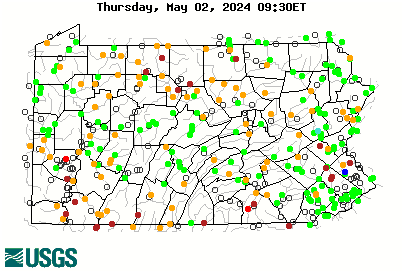Class A Wild Trout Team in Pennsylvania ©Dave Kile
Origins & Purpose: Pennsylvania’s Class A Wild Trout Program
If you’re new to trout fishing in Pennsylvania, you might hear seasoned anglers talking about "Class A Wild Trout Streams." These streams are considered by many to be some of the best places in the state to find naturally reproducing trout. But what exactly does "Class A" mean, and why are these waters so important?
A Turning Point in 1983: Operation Future
Back in the early 1980s, the Pennsylvania Fish & Boat Commission (PFBC) was looking for a better way to manage trout fishing. At the time, most trout fishing relied on stocking hatchery-raised fish. But biologists noticed that some streams had wild trout populations strong enough to support fishing without any stocking.The PFBC introduced the Resource First concept in 1981, marking a major shift in how the state manages its aquatic resources. Instead of prioritizing recreational fishing alone, this philosophy placed the protection, conservation, and long-term sustainability of fish populations and aquatic habitats at the center of decision-making. It recognized wild, self-sustaining fish populations as renewable natural assets and supported stocking only where natural reproduction could not meet angling demand.
In 1983, PFBC launched Operation Future, a program designed to manage trout fisheries based on science and sustainability. Rather than focusing only on stocking, the new goal was to protect streams where trout could reproduce naturally and survive on their own. These high-quality waters were given the official label: "Class A Wild Trout Streams."
Operation Future wasn’t just an operational shift—it was a cultural transformation for fisheries management in Pennsylvania. It elevated wild trout conservation from an ideal to a structured, enforceable policy guided by science.
What Makes a Stream Class A?
To earn Class A status, a stream has to meet strict standards. PFBC biologists survey the stream to determine the number and size of wild trout. If the stream has enough naturally reproducing trout to support long-term fishing without help from hatcheries, it can be designated as Class A.There are different classifications for different trout species, including brook trout, brown trout, and even a few with rainbow trout. Some streams have strong populations of both brook and brown trout. As of 2025, there are nearly 2,000 miles of Class A streams in Pennsylvania.
Why Class A Matters
Class A streams are protected and managed differently. Because they don’t need stocked trout, efforts can focus on preserving wild fish and maintaining healthy habitats. Many of these streams are also designated High-Quality Coldwater Fisheries, which gives them extra protection under state water quality laws.For anglers, Class A streams offer a unique experience:
- The trout are wild, not stocked, so they tend to be more wary, stronger fighters, and more vibrantly colored.
- These waters are typically found in clean, scenic environments like state forests and parks.
- Fishing these streams helps sharpen your skills—reading water, matching hatches, and adapting to conditions.
- You become part of a conservation tradition by fishing responsibly in streams where trout populations thrive naturally.
- While Wild Trout streams may not be as well known to newer anglers, they offer a unique and memorable opportunity for those looking to expand their fly fishing experiences.
- Many of these waters are home to native brook trout—the only trout species native to Pennsylvania and the official state fish. Catching and releasing these beautiful fish is a special reward.
Wild Brook Trout in Union County
Why Wild Trout Thrive Without Stocking
When stocking stops on Class A streams, wild trout often thrive. Here’s why:- Less Competition: Hatchery trout compete with wild trout for food, shelter, and space, which can suppress wild trout reproduction and survival.
- Reduced Disease and Genetic Risks: Hatchery fish can bring diseases like gill lice or whirling disease, and their genetics can weaken the natural adaptations of wild trout if they interbreed.
- Natural Habitat Reclamation: Without the disruption caused by frequent stocking, wild trout populations become more balanced and resilient. The stream’s ecosystem begins to recover naturally, supporting a more stable and healthy fishery.
Stocking Controversy
Not all anglers agree on how to manage Class A streams. Some of these waters are still stocked, especially near urban areas or where fishing pressure is high. This has led to debates: Should we protect wild trout as planned, or continue stocking to meet business needs?PFBC now uses a specific set of guidelines to decide when it’s appropriate to stock a Class A stream. Factors include species overlap, angling demand, and whether stocking could negatively impact wild trout populations.
These special waters will remain for future generations only if we protect them—from pollution, habitat destruction, and inappropriate stocking.
Stocked waters have an important place in Pennsylvania’s trout program, but protecting wild trout and their habitats is just as vital.
Real-World Examples
In the upper Kettle Creek watershed, special regulations helped increase the size and number of brook trout, leading to greater protections. Another stream, Crooked Run, has one of the highest wild brook trout populations ever recorded in the state. These examples show what can happen when wild fish are given space, protection, and clean water to thrive.Final Thoughts
The Class A program is one of the reasons Pennsylvania is known for its exceptional wild trout fishing. It blends science, conservation, and the love of the sport. If you’re just getting into trout fishing, learning about these special waters is a great first step toward becoming a skilled, thoughtful angler. And who knows? Your next big catch might come from a Class A stream—a fish born and raised in one of Pennsylvania’s wildest places.Sources and Additional Reading:
Last edited:




